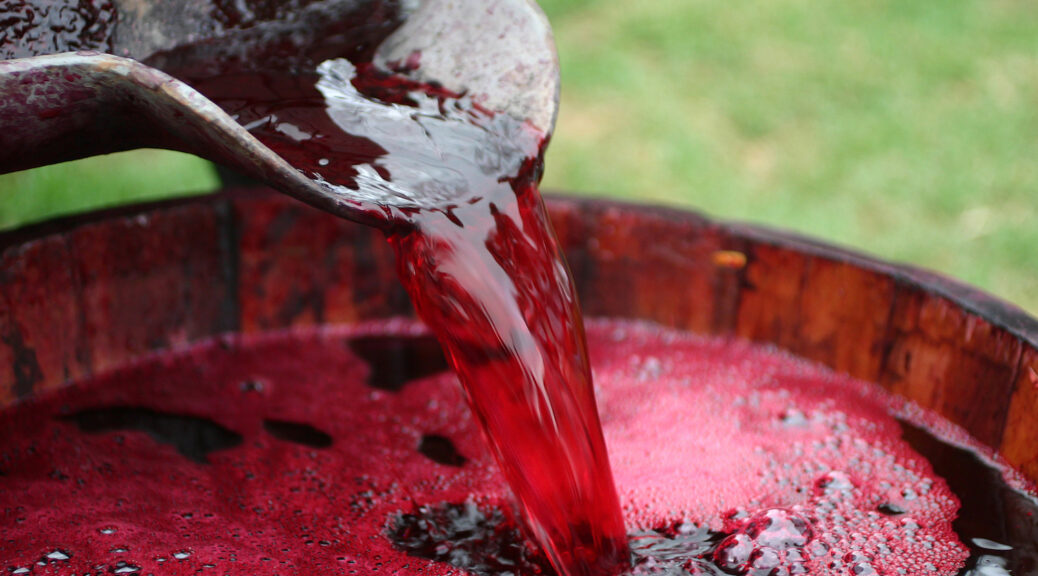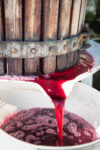
Making Homemade Wines – Blackberry, Tomato, Rhubarb, and more
INFORMATION BELOW FROM 1800s COOKBOOKS
CURRANT, CHERRY, AND OTHER BERRY WINES
The juice of either of the above fruits can be used alone or in combinations to make a variety of flavors. Express all the juice you can, then take an equal amount of boiling water and pour on the pressed fruit. Let this stand two hours, squeeze out as much as there is of juice, and mix. Then add 4 pounds of brown sugar to each gallon of the mixture. Let stand until worked, usually 3 or 4 weeks. Put a piece of gauze over the bung hole* to keep out flies and when it is done working, bung it up.
A cool cellar, of course, is the best place for keeping wines, as they must be kept where they will not freeze. If bottled, always lay them on the side.
*bung hole – a hole bored in a liquid-tight barrel to remove contents. The hole is capped with stopper called a bung.
RHUBARB, OR ENGLISH PATENT WINE
An agreeable and healthful wine is made from the expressed juice of the garden rhubarb. These stalks will furnish about three-fourths their weight in juice. To each gallon of juice, add 1 gallon of soft water* in which 7 pounds of brown sugar has been dissolved. Fill a keg or a barrel with this proportion, leaving the bung out. Keep it filled with sweetened water as it works over,* until clear. Then bung down or bottle as you desire.
Fill the barrels and let them stand until spring and bottle, as any wine will be better in glass or stone.
*soft water – water that has very low mineral content, such as rain water.
*work over – ferments.
ANOTHER
For every 4 pounds of the stalks cut fine, pour on 1 gallon of boiling water, adding 4 pounds brown sugar. Add a little cinnamon, allspice, cloves and nutmeg, bruised, as may be desired for flavoring. Let stand covered 24 hours, strain and let it work a few days, and bottle.
TOMATO WINE
Express the juice from clean, ripe tomatoes. Something of the character of a cheese press, hoop and cloth, is the best plan to squeeze out the juice of tomatoes or other fruits. To each gallon of juice, put 4 pounds brown sugar. Put in the sugar immediately, or before fermentation begins–which ought to be done in making any fruit wine. Let the wine stand in a keg or barrel for two or three months, then draw off into bottles, carefully avoiding the sediment. It makes a most delightful wine, having all the beauties of flavor belonging to the tomato. It must be tasted to be appreciated.
BLACKBERRY WINE
Mash the berries and pour 1 quart of boiling water to each gallon of berries. Let the mixture stand 24 hours, stirring occasionally. Then strain and measure into a keg, adding 2 pounds of sugar, and one pint good rye whisky to each gallon.
Cork tight, and let it stand until the following October, and you will have wine fit for use, without further straining or boiling. This wine is invaluable in sickness as a tonic, and nothing is better for bowel disease.
PORT WINE
Mash two bushels fully ripe wild grapes without breaking the seed. Put them into a barrel with 25 pounds sugar and 3 gallons best alcohol. Fill up with rain water and let it lie a few weeks in the sun, or if the weather has become cold, in a warm place. Then put in the cellar until spring. Rack off and bottle, or place in perfectly clean kegs or barrels, and you have a better article than nine-tenths of what is represented as imported Port.
CIDER WINE
Let the new cider from ripe, sour apples ferment from 1 to 3 weeks, as the weather is warm or cool. When it has attained to a lively fermentation, add to each gallon, according to its acidity, from 1/2 pound to 2 pounds of white crushed sugar. Let the whole ferment until it possesses precisely the taste desired to be permanent. In this condition, pour out a quart of the cider and add for each gallon 1/4 ounce of sulphite of lime, not sulphate. Stir the powder and cider until intimately mixed, and return the emulsion to the fermenting liquid. Agitate briskly and thoroughly for a few moments, and then let the cider settle. Fermentation will cease at once.
When, after a few days, the cider has become clear, draw off carefully to avoid the sediment, and bottle. If loosely corked, which is better, it will become a sparkling cider wine, and may be kept indefinitely.
GRAPE WINE
Take 20 pounds ripe, freshly picked and selected, tame grapes. Put them into a stone jar and pour over them 6 quarts of boiling soft water. When sufficiently cool to allow it, you will squeeze them thoroughly with the hand. Allow them to stand 3 days on the pomace* with a cloth thrown over the jar. Then squeeze out the juice, add 10 pounds of nice crushed sugar, and let it remain a week longer in the jar. Take off the scum, strain and bottle, leaving a vent, until done fermenting. Strain again, bottle tight, and lay the bottles on the side in a cool place.
Some wine makers say if care is observed when the juice is pressed out to keep clear of the pomace, wine is better to stand without racking or straining. Nothing is found in the barrels after the first year, save the crude tartar, which all grape wine deposits on the sides of the cask.
* pomace or marc – the solid remains of grapes, olives, or other fruit after pressing for juice or oil. It contains the skins, pulp, seeds, and stems of the fruit.
Image from Deposit Photos
=================================================
Have You Ever Made or Tasted Homemade Wine?
Please Leave a Comment Below.
=================================================
